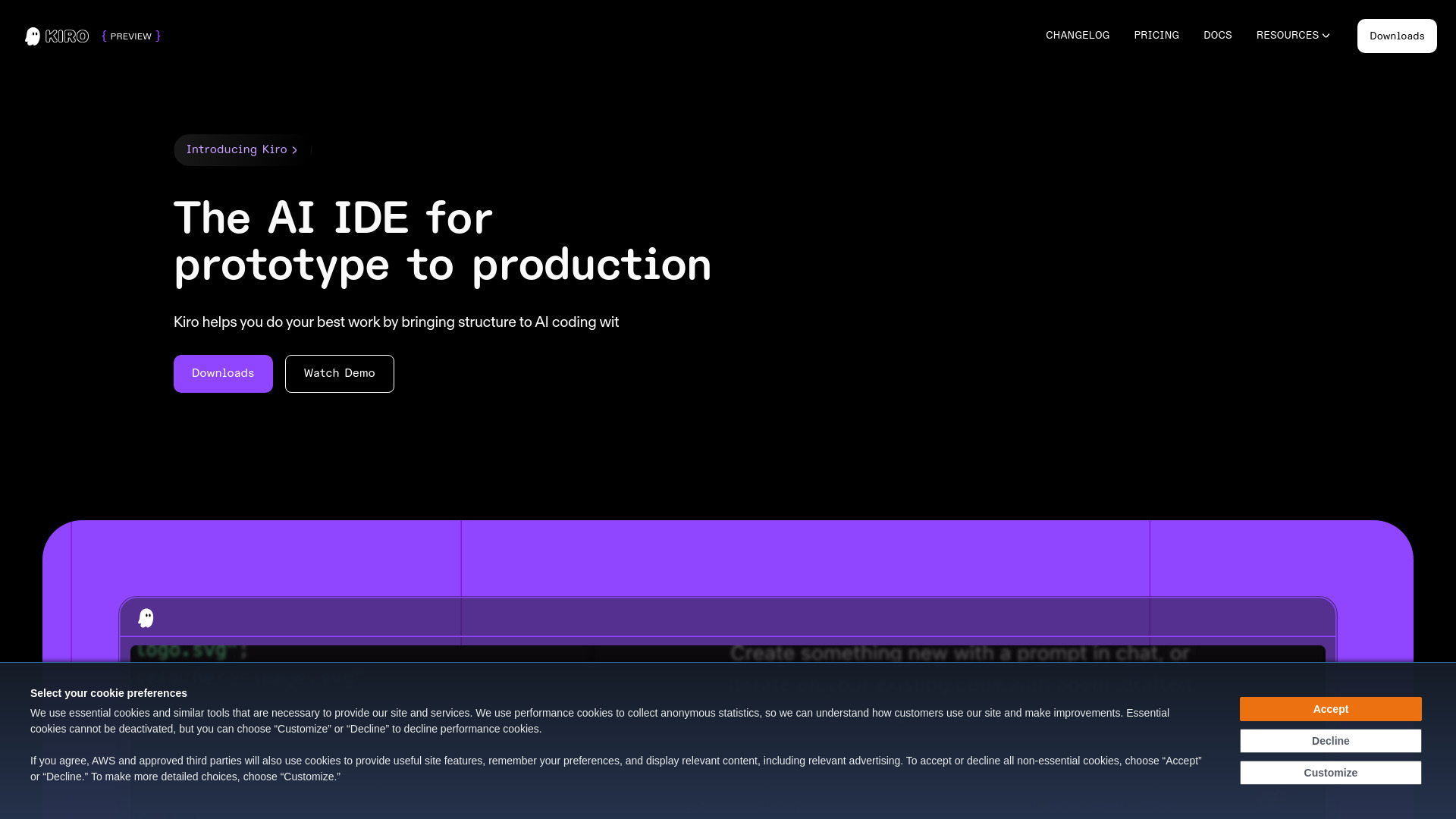- Home
- AI Code Assistant
- Kiro

Kiro
Open Website-
Tool Introduction:AI IDE for spec-driven development: go from prototype to production.
-
Inclusion Date:Oct 21, 2025
-
Social Media & Email:
Tool Information
What is Kiro AI
Kiro AI is an AI-first Integrated Development Environment that streamlines the path from prototype to production. It centers on spec-driven development: you define clear inputs, outputs, constraints, and success criteria, and Kiro organizes code, prompts, and data around that contract. With agent hooks, you can automate repetitive steps, orchestrate background tasks, and bind agents to events. Flexible integrations connect models, tools, and datasets so teams can build reliable AI software with traceable workflows and predictable outcomes.
Kiro AI main features
- Spec-driven development: Define executable specs that act as contracts, aligning prompts, code, and data to reduce ambiguity and improve reproducibility.
- Agent hooks and automation: Trigger agents on events, schedules, or pipeline states to eliminate boilerplate and keep long-running tasks coordinated.
- Tool and data integration: Connect models, APIs, databases, and vector stores to compose end-to-end AI workflows with consistent interfaces.
- From prototype to production: Evolve projects without rewrites using versioned specs, environment configs, and deployment-friendly layouts.
- Testing and evaluation: Attach test cases and success criteria to specs to evaluate changes and prevent regressions.
- Traceability: Capture inputs, outputs, and decisions across runs for auditing, debugging, and continuous improvement.
- Collaboration: Share structured specs that make reviews, handoffs, and cross-team work clearer and faster.
- Extensibility: Add custom tools and adapters through hooks to fit unique workflows and infrastructure.
Kiro AI suitable for
Kiro AI suits software engineers, ML engineers, and data practitioners building LLM-powered applications and agents. It helps platform teams standardize AI development, startups accelerate prototypes into reliable products, and enterprise teams integrate models, tools, and data under consistent governance. Use it for chatbots, retrieval-augmented apps, workflow agents, and AI features embedded in existing products.
Kiro AI usage steps
- Create a project and write a spec that defines inputs, outputs, constraints, and success metrics.
- Connect required models, tools, and data sources; configure credentials and environment variables.
- Implement agents, prompts, and functions that adhere to the spec’s interface.
- Add agent hooks to automate triggers, background tasks, and cross-tool orchestration.
- Run local experiments and evaluations against the spec to validate behavior.
- Iterate on prompts and code, version your spec, and document assumptions.
- Integrate with your repository and CI to run checks and evaluations on each change.
- Deploy to staging and production, monitor runs, and refine based on feedback and metrics.
Kiro AI industry cases
An e-commerce team builds a retrieval-augmented support agent: the spec defines user intents, tool calls, and success thresholds; hooks sync product data nightly and run regression checks. A fintech team prototypes a fraud-triage assistant, integrating risk APIs and setting spec-bound guardrails before promoting to production. A healthcare provider drafts intake and summarization workflows, using specs to align PHI handling and evaluation criteria across teams.
Kiro AI pricing
Pricing and plan availability can change over time. For current details on subscriptions, enterprise options, and any free trials, please refer to the official Kiro AI website or contact the vendor directly.
Kiro AI pros and cons
Pros:
- Brings structure with spec-driven development for clarity and repeatability.
- Agent hooks reduce manual glue work and enable robust automation.
- Flexible integration layer connects models, tools, and data sources.
- Smoother transition from prototyping to production with versioned specs.
- Improved traceability for auditing and debugging complex AI workflows.
Cons:
- Initial learning curve to adopt spec-driven practices and hooks.
- Integration setup may require upfront configuration and governance.
- Complex multi-agent systems can be harder to debug without disciplined specs.
- Platform dependence may limit flexibility if needs outgrow supported patterns.
Kiro AI FAQs
-
What is spec-driven development in Kiro AI?
It is a methodology where you codify inputs, outputs, constraints, and success criteria up front. Code, prompts, and data are organized around this contract to ensure consistency and testability.
-
How do agent hooks help?
Hooks bind agents to events or schedules, automating routine tasks, coordinating multi-step flows, and reducing boilerplate orchestration code.
-
Can I bring my own models and tools?
Yes. Kiro AI is designed to integrate external models, APIs, and data systems so you can compose the stack that fits your application.
-
Does Kiro AI work with existing CI/CD?
You can align specs and evaluations with your repository and pipelines to enforce checks on each change before deployment.
-
How does Kiro AI improve reliability?
By enforcing clear contracts, attaching evaluations, and capturing traces, it enables repeatable behavior and faster detection of regressions.
-
Is Kiro AI suitable for small teams?
Yes. The structure reduces coordination overhead and helps small teams scale from first prototype to production without rewrites.



